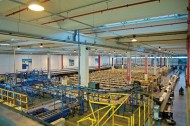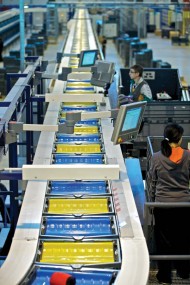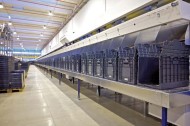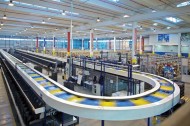Oxylane has an integrated supply chain for its Decathlon stores. The Europe-wide structure has a primary level of distribution based around International Depots and a secondary level based around Regional Depots. The latter serve the Stores and provide them with a continual supply of goods that are ready to go on sale on the shop floor and divided by “Sport Universe” and product type. The three Italian depots in Milan, Bologna and Caserta serve the stores in the North, Centre and South of the country respectively.
AUTOMATIC DISTRIBUTION
SDI has designed and made sorter-based automatic distribution solutions featuring its own mechanical and computer technology for the three depots in Italy (as well as another four in France and two in Spain).
A “pick and sort” approach has been taken for all of the goods, with the exception of unusual, heavy and bulky items that do not fit in the standard packaging.
SERVICE FOR THE STORES
The use of sorters and standard packaging for the Sport Universes and goods types has optimized distribution to the stores and freed up human resources within them, so that people who were previously occupied sorting and stacking the goods on the shelves can now devote their time to serving and assisting the customers.
THE PROJECT
 Decathlon is a retail chain in the Oxylane Network. It has 610 stores in 17 different countries worldwide. The majority of them are in France (239), Spain (84), Italy (69), China (33), Poland (20) and Portugal (18). Decathlon has been in Italy since the early 1990s, when the first store opened in Baranzate, near Milan.
Decathlon is a retail chain in the Oxylane Network. It has 610 stores in 17 different countries worldwide. The majority of them are in France (239), Spain (84), Italy (69), China (33), Poland (20) and Portugal (18). Decathlon has been in Italy since the early 1990s, when the first store opened in Baranzate, near Milan.
Oxylane’s European logistics network is based around two levels: international depots and regional depots. The international depots serve as central storage areas for the stock, while the regional depots prepare the deliveries for the stores, which keep little or no stock in the back areas and thus need a regular, frequent supply of goods from the logistics network.
The logistics network in Italy has developed hand in hand with the retail network. There are now three regional depots, in Basiano (near Milan), Castel San Pietro (near Bologna) and Maddaloni (near Caserta). They dispatch to three different geographical areas of the country: the first serves the North, the second serves the Centre and the third serves the South and the Islands.
The project was a Europe-wide scheme for an Integrated Supply Chain with a final objective of supporting the sales phase so that the human resources could be efficiently reorganized and provide a higher standard of service to the end customers.
Part of the planned system was an automatic sorter to manage the distribution process.
Oxylane/Decathlon asked SDI to design and make a distribution sorter to support the project as a whole. It supplied the client with a solution that could be adapted to the different sites. The same operating interface and computerized management system is used in all of them.
THE DISTRIBUTION PROCESS
The three depots manage a number of flows.
One of these flows comes from the central European depots. The goods are sorted and any items which cannot be dealt with by the sorter are taken directly to the dispatch area without being stocked. All of the other items are managed by the sorter. The second – and predominant – flow involves shipping the stocked items which are ordered by the stores. They will come from one of two large storage and picking areas, depending on the size of the items, and therefore the possibilities for sorting them. The goods that are picked in the two areas come together in the consolidation zone, where the orders for each store are put together. The items are subsequently checked to ensure that they correspond with the order and they are then loaded on to the vehicles.
The average daily flow of items that can be managed by the sorters on each site is approximately 35,000/40,000 lines of orders. They are stocked in cardboard boxes of various sizes on shelves that are 1.8 m tall. The orders to be dispatched are divided up into picking waves. In each wave, several members of staff – who work in specific areas – pick the amount required for a number of orders from the stores. The items are put in baskets and taken to the input areas for the sorters, where a pallet elevator puts the baskets at the right height to feed the sorter. A member of staff will scan the barcode of each item before putting it on the sorter tray.
The items will now be in the sorter’s circular system.
The standard output of the sorter is 6,500 trays an hour. This can be doubled by using two input stations and “sorter logic” which allows the trays to be used twice during the cycle. The sorter’s computer system allows the outputs to be assigned dynamically. Decathlon can thus work with picking waves for order quantities that are up to 20% higher than the sorter output numbers.
 Members of staff are present at the sorter chutes and check when the containers are full. A serial barcode that refers to the store and the order is attached to each carton. This information is used by the WMS to complete the order. When the cartons reach the printing point, shipping labels are attached to them. They are then sent to the consolidation area and go through a carton sorter.
Members of staff are present at the sorter chutes and check when the containers are full. A serial barcode that refers to the store and the order is attached to each carton. This information is used by the WMS to complete the order. When the cartons reach the printing point, shipping labels are attached to them. They are then sent to the consolidation area and go through a carton sorter.
Downstream from the outputs, the orders for the stores are put together in unit loads on pallets. The unit loads are placed in the dispatch area, ready to be loaded on the vehicles.
Oxylane has selected more than 25 shop floor presentation systems. This reduces the amount of time required to stack the shelves in the stores, so the staff are free to help the end customers and sell the products.
The shipping containers are made of plastic. Once they have been emptied, the staff at the stores fold them up and send them back to the central depot.
LAYOUT
The sorters have the same mechanical sorting and computerized management systems on all three sites.
The depot in Caserta is a new construction, so SDI was asked to design and make a carton sorter for the incoming goods area that was connected to a telescopic conveyor for counting the incoming packages and checking that they match the ASN while also dividing the goods by processing area (Sorter, Non-Sorter, Transit and Stock), and a carton sorter for the dispatch area with dynamic assignment of the outputs according to the destinations (Stores) of the goods emerging from the Sorter.
The existing sites in Bologna and Milan already had equipment in place. They asked for the addition of a sorter, a take-away conveyor and a printing and labelling machine in the phase prior to the sorting by destination (the second and third items of equipment were also included in the solution for Caserta).
COMPANY PRESENTATION OXYLANE – DECATHLON
Decathlon was founded in 1976. Since then, it has undergone rapid development on a number of continents.
The idea behind the founding of Decathlon was to allow sports enthusiasts of any standard to find products for 74 different sports under the same roof. (“Making the pleasures and benefits of sport desirable and accessible to as many people as possible.”)
The company’s mission is to create the best products possible for taking part in each sport.
With this in mind, in 1997 it started developing its “passion brands”. There are now 18 of these labels, which offer highly specialized clothing and equipment for specific sports. As well as being innovative, they offer guaranteed quality, comfort and safety.
SDI GROUP
 SDI GROUP designs, produces and supports integrated handling and distribution systems for the Retail, Supermarket, Textiles, Multimedia and E-Commerce sectors.
SDI GROUP designs, produces and supports integrated handling and distribution systems for the Retail, Supermarket, Textiles, Multimedia and E-Commerce sectors.
It offers turnkey solutions, carrying out size and production analyses in the design phase and acting as a Systems Integrator in the operating phase. The main design objective is to meet the specific needs of the client.
SDI Group
Tel: 01763 244 299





Comments are closed.